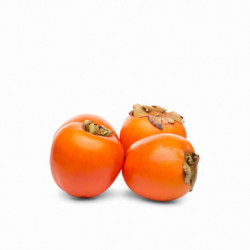- Out-of-Stock


Persimmon is an autumn fruit characterized by its firm and fleshy pulp, orange color, and sweet flavor. It can be consumed like an apple, peeled and sliced into pieces or slices, or cooked to make sauces, chutneys, pies, cakes, custards, and other sweet and savory recipes. Persimmon differs from traditional or Diospyros kaki in that it does not need to ripen as much to be edible and has a crunchier and less gelatinous texture. From a gastronomic point of view, persimmon is a versatile and aromatic fruit that adds color, sweetness, and juiciness to dishes.
 Security policy
Security policy
Website built using newest versions, SSL protocols, Secure payments
 Delivery policy
Delivery policy
Receive your order in 24-48h
 Return policy
Return policy
100% Satisfaction guarantee

Guarantee safe & secure checkout
The persimmon persimon, also known as kaki or dragon fruit, is a fruit native to Asia that has spread worldwide. In this report, we will address the gastronomy, history, health, agriculture, and botany of the persimmon persimon and its varieties.
The persimmon persimon belongs to the Ebenaceae family and is native to China, Japan, and Korea. Its scientific name is Diospyros kaki, and it is cultivated in warm and subtropical areas worldwide. It is a deciduous tree that can grow up to 20 meters tall. The flowers are small, white-yellowish, and grouped in clusters on the branches. There are two main types of persimmon persimon: astringent and non-astringent.
The persimmon persimon is cultivated worldwide, especially in countries like China, Korea, Japan, Spain, Italy, and the United States. Most crops are found in warm and subtropical regions, where temperatures are high during summer and moderate during winter.
The persimmon persimon can be consumed both fresh and cooked. It is a very versatile fruit used in a variety of dishes, from desserts to savory dishes. It is an excellent source of vitamins A and C, fiber, and antioxidants. In cooking, the astringent persimmon persimon is used to make a sweet paste called hoshigaki in Japan, made by slowly drying the fruit in the sun and periodically rubbing it to break the fibers and soften the texture. It can also be used to make jams, cakes, and sauces. The non-astringent persimmon persimon is ideal for eating raw as fresh fruit. It can also be used in salads, sauces, and desserts such as pies and ice creams.
The persimmon persimon has been cultivated in Asia for over 2,000 years and has been used in traditional Chinese medicine to treat respiratory problems and diarrhea. In the 19th century, the persimmon persimon was introduced to the United States by Japanese immigrants and became a popular crop in California.
The persimmon persimon is a healthy and nutritious fruit. It is rich in vitamins A and C, antioxidants, and fiber. Studies have shown that regular consumption of persimmon persimon can reduce the risk of heart disease, cancer, and diabetes. It is also beneficial for eye health.
There are many recipes with persimmon persimon that you can prepare to enjoy this autumn fruit. For example, you can make appetizers, salads, sauces, side dishes, pies, cakes, custards, and other sweet and savory delights.
Get creative with persimmon persimon in the kitchen!